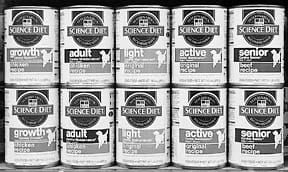Virtually every dog food on the market complies with the labeling regulations and meets the nutrient standards suggested by the Association of American Feed Control Officials (AAFCO); go look at the fine print on your dog’s food label. It will have one of two statements on it, indicating which of two AAFCO standards it supposedly met: either a “feeding trial” or chemical analysis of the food. The problem is, that particular food may have passed neither test itself.
What?
Let’s back up.

We’ve talked about AAFCO before (see “Who’s in Charge?” WDJ December 2000). It’s a nongovernment, voluntary, advisory organization of state feed control officials, who interact with and influence state and federal feed industry regulators. Most states require that dog food made and/or sold in their borders meet a standard meant to guarantee nutritional benefit to the dogs who eat it, and most states use AAFCO-developed standards.
AAFCO uses two methods to “prove” that a food is adequate to the task of keeping dogs alive. The first is a feeding trial, where the food is fed to a certain number of dogs for a certain amount of time, and as long as most of the dogs live, the food gets to go to market with a label that says something like, “Animal feeding tests using AAFCO procedures substantiate that (product name) provides complete and balanced nutrition for (life stage).” Never mind that, in our opinion, these trials are woefully inadequate; we’ve discussed that before and we will again in the future.
The second standard is basically a chemical analysis that confirms the food contains levels of nutrients that fall within a range determined by AAFCO to be sufficient to support canine life. The way it’s supposed to work is that foods that have not been tested in a feeding trial have labels that say, “(Name of product) is formulated to meet the nutritional levels established by the AAFCO nutrient profiles.” Again, never mind that we and many other pet food-industry critics take issue with the nutrient profiles. We’ve got other fish to fry today.
Pet food ‘families’
Here is our problem: AAFCO recently amended its regulations to allow foods that are comparable in nutritional adequacy to a food that actually passed a feeding trial to bear the exact same label claim.
A food that has passed an actual feeding trial can now serve as the “lead food” for a “family” of foods; and the standards required for the “family members” are not nearly as rigorous (if we can use that verbiage in relation to pet food production) as for the lead food.
To be in “the family,” a food must meet the following criteria:
• The moisture content must be similar to the lead food. This requirement simply ensures that dry foods stay in a dry food family, a canned food is in a canned food family, etc. For example, both the lead food and any family members must be under 20 percent moisture (“dry” foods), 20-65 percent moisture (“semi-moist” foods), or over 65 percent moisture (canned foods).
• The “metabolizable energy” (ME) content of the family member must be within 7.5 percent of the tested food – which more or less means they should have similar calorie counts. This must be validated by feeding the family member food to six animals for 10 days. The first five days are so the animals can acclimate to the food. During the last five days, the animals’ stools are collected and their energy content assayed by calorimetry. The difference between the amount of food eaten and the amount of stool excreted, with a correction for urinary losses, equals the ME of the food.
This is the only time that the “family member” foods must be fed to live animals before they arrive at the retail store shelves.
There is an optional test for ME that uses calculations rather than the feeding protocol, but it is unlikely that any manufacturer will ever use it, because it would have to state outright on the label that the food is “comparable in nutritional adequacy to a product which has been substantiated using AAFCO feeding tests.” Rather than admit that on the label, manufacturers will most assuredly use the relatively lenient 10-day ME test.
• The family member must also meet the levels contained in the lead food for a few crucial values: crude protein, calcium, phosphorus, zinc, lysine, and thiamine. (For cat foods, the family members must also meet specified minimums of potassium and taurine.)
• The family member may claim adequacy for only the same or a less-demanding life stage than the lead food. (Life stages are, in descending order of demand: “all life stages,” “gestation/lactation,” “growth,” and “maintenance.”)
• Finally, the family member must meet or exceed the nutrient levels of the lead food or as specified by the AAFCO Nutrient Profiles for all other nutrients, whichever is lower.
Good news for manufacturers
This is very good news for the pet food manufacturers, because they no longer have to perform expensive feeding tests in order to market a food with the feeding test claim – a “higher” standard in most consumers’ eyes. This gives family member foods a potential marketing advantage over foods that “only” meet the requirements of the AAFCO Nutrient Profiles.
The new family rule also allows food makers to fast-track the development and marketing of new formulas. In case you were wondering, this is the mechanism that has permitted the rapid proliferation of such things as special formulas for dogs with sensitive skin or tender tummies, breed-specific formulas, and odor-reducing formulas on the shelves of your local pet superstores and grocery stores.
Bad news for consumers
Is it good news for you? True – it has resulted in a much wider selection of foods to choose from at the store.
But until recently, we used to be able to trust that, if a food claimed it had been tested using AAFCO feeding protocols, it had at the very least kept a handful of dogs alive for six months. Now, we have no assurance at all, because we can’t tell which food is a lead food that was really tested, and which one is the copycat. This is particularly bad news because the lead food, which has passed feeding tests, is not itself required to meet the AAFCO Nutrient Profiles. Thus, a family member food could be significantly below the recommendations of the Nutrient Profile for many nutrients, yet never be required to prove it can keep animals going, even for six months. Small differences in formulation could mean big differences in how digestible and bioavailable certain nutrients are to the dog, but the only way you’ll find this out is when your dog develops a problem because of it!
I know I keep saying this, but it’s another case of “let the buyer beware!” Always keep an eye on your dog when trying out a new food to make sure it’s working for him. He should have good energy, a normal appetite, clear eyes, a shiny coat, no dandruff, and normal stools. If anything seems “off,” look to his food first for the cause.
On the other hand, if your dog displays every sign of good health and has no worrisome symptoms of chronic health problems (such as recurrent ear infections, “hot spots,” or digestive troubles), don’t give in to the impulse to switch to the newest food on the pet store shelves just because its bag is newer, shinier, or cheaper, or labeled as just right for Airedale-crosses from the East Coast or all dogs with “sensitive skin.” It’s probably an untested newcomer to a over-accepting “family.”
-By Jean Hofve, DVM
Dr. Jean Hofve is the Companion Animal Program Coordinator for the Animal Protection Institute, located in Sacramento, California.





